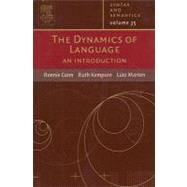
Note: Supplemental materials are not guaranteed with Rental or Used book purchases.
Purchase Benefits
What is included with this book?
| Preface | ix | ||||
| 1. The Point of Departure | 1 | (30) | |||
|
3 | (17) | |||
|
6 | (2) | |||
|
8 | (3) | |||
|
11 | (9) | |||
|
20 | (4) | |||
|
21 | (3) | |||
|
24 | (5) | |||
|
26 | (3) | |||
|
29 | (2) | |||
| 2. The Dynamics of Interpretation | 31 | (54) | |||
|
31 | (3) | |||
|
34 | (7) | |||
|
35 | (1) | |||
|
36 | (2) | |||
|
38 | (3) | |||
|
41 | (18) | |||
|
42 | (3) | |||
|
45 | (4) | |||
|
49 | (6) | |||
|
55 | (4) | |||
|
59 | (8) | |||
|
67 | (13) | |||
|
73 | (7) | |||
|
80 | (5) | |||
| 3. Relative Clause Construal | 85 | (56) | |||
|
85 | (17) | |||
|
86 | (2) | |||
|
88 | (5) | |||
|
93 | (1) | |||
|
94 | (8) | |||
|
102 | (15) | |||
|
106 | (4) | |||
|
110 | (4) | |||
|
114 | (3) | |||
|
117 | (22) | |||
|
118 | (5) | |||
|
123 | (6) | |||
|
129 | (5) | |||
|
134 | (3) | |||
|
137 | (2) | |||
|
139 | (2) | |||
| 4. Tree Growth and Language Typologies | 141 | (46) | |||
|
142 | (24) | |||
|
143 | (6) | |||
|
149 | (7) | |||
|
156 | (6) | |||
|
162 | (2) | |||
|
164 | (2) | |||
|
166 | (18) | |||
|
169 | (4) | |||
|
173 | (10) | |||
|
183 | (1) | |||
|
184 | (3) | |||
| 5. On the Right Periphery | 187 | (40) | |||
|
187 | (1) | |||
|
188 | (5) | |||
|
193 | (12) | |||
|
194 | (4) | |||
|
198 | (4) | |||
|
202 | (3) | |||
|
205 | (16) | |||
|
207 | (3) | |||
|
210 | (2) | |||
|
212 | (3) | |||
|
215 | (6) | |||
|
221 | (2) | |||
|
223 | (4) | |||
| 6. The Challenge of Japanese | 227 | (64) | |||
|
227 | (7) | |||
|
230 | (1) | |||
|
231 | (3) | |||
|
234 | (8) | |||
|
236 | (4) | |||
|
240 | (1) | |||
|
241 | (1) | |||
|
242 | (10) | |||
|
243 | (5) | |||
|
248 | (4) | |||
|
252 | (15) | |||
|
257 | (3) | |||
|
260 | (7) | |||
|
267 | (3) | |||
|
270 | (18) | |||
|
271 | (11) | |||
|
282 | (6) | |||
|
288 | (3) | |||
| 7. Swahili Agreement and Conjunction | 291 | (42) | |||
|
292 | (7) | |||
|
293 | (1) | |||
|
294 | (1) | |||
|
295 | (4) | |||
|
299 | (9) | |||
|
308 | (16) | |||
|
310 | (6) | |||
|
316 | (2) | |||
|
318 | (3) | |||
|
321 | (3) | |||
|
324 | (8) | |||
|
325 | (2) | |||
|
327 | (2) | |||
|
329 | (3) | |||
|
332 | (1) | |||
| 8. Copula Constructions in English | 333 | (40) | |||
|
333 | (8) | |||
|
336 | (3) | |||
|
339 | (2) | |||
|
341 | (8) | |||
|
345 | (2) | |||
|
347 | (2) | |||
|
349 | (12) | |||
|
352 | (5) | |||
|
357 | (4) | |||
|
361 | (8) | |||
|
362 | (4) | |||
|
366 | (3) | |||
|
369 | (2) | |||
|
371 | (2) | |||
| 9. General Perspectives | 373 | (42) | |||
|
374 | (3) | |||
|
377 | (11) | |||
|
378 | (2) | |||
|
380 | (8) | |||
|
388 | (9) | |||
|
388 | (2) | |||
|
390 | (1) | |||
|
391 | (5) | |||
|
396 | (1) | |||
|
397 | (9) | |||
|
398 | (4) | |||
|
402 | (2) | |||
|
404 | (2) | |||
|
406 | (2) | |||
|
408 | (7) | |||
| Bibliography | 415 | (16) | |||
| Subject Index | 431 |
The New copy of this book will include any supplemental materials advertised. Please check the title of the book to determine if it should include any access cards, study guides, lab manuals, CDs, etc.
The Used, Rental and eBook copies of this book are not guaranteed to include any supplemental materials. Typically, only the book itself is included. This is true even if the title states it includes any access cards, study guides, lab manuals, CDs, etc.